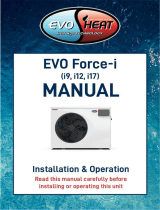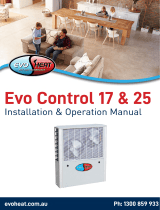
Page | 2
Contents
1. Preface ................................................................................................................................................................................... 3
2. Specifications .......................................................................................................................................................................... 4
2.1 Specification Data .......................................................................................................................................................... 4
2.2 Unit Dimensions ............................................................................................................................................................. 5
2.3 Performance Curve ........................................................................................................................................................ 6
3. Installation and Connection ..................................................................................................................................................... 7
3.1 Safety Precautions.......................................................................................................................................................... 7
3.2 Transit ......................................................................................................................................................................... 10
3.3 Installation Notes ......................................................................................................................................................... 10
3.4 Location of the Unit ...................................................................................................................................................... 10
3.5 Water Loop Connection ................................................................................................................................................ 11
3.6 Water Pump................................................................................................................................................................. 11
3.7 Electrical Wiring and Power Supply ............................................................................................................................... 12
3.8 Prior to Trial Operation................................................................................................................................................. 12
3.9 Trial Operation ............................................................................................................................................................. 13
3.10 Maintenance ................................................................................................................................................................ 13
4. Controlling and Operation ..................................................................................................................................................... 14
4.1 Controller Display ......................................................................................................................................................... 14
4.2 How to Use the Controller ............................................................................................................................................ 14
4.2.1 Power On ..................................................................................................................................................................... 14
4.2.2 Start Unit ...................................................................................................................................................................... 14
4.2.3 Stop Unit ...................................................................................................................................................................... 15
4.2.4 Check the Data ............................................................................................................................................................. 15
4.2.5 Check the Setting Data and Amend the Settings............................................................................................................. 16
4.2.6 Exit Data Settings .......................................................................................................................................................... 18
4.3 Parameter Table ................................................................................................................................................................... 18
4.4 Compensate Temperature Chart ................................................................................................................................... 19
5. Troubleshooting .................................................................................................................................................................... 20
5.1 Ordinary Malfunctions & Solutions ....................................................................................................................................... 20
5.2 Fan Speed Control ................................................................................................................................................................ 21
5.3 BHB10 Malfunction Table ..................................................................................................................................................... 22
5.3.1 Common Failures: Causes & Solutions ........................................................................................................................... 22
5.4 PCB Connection Illustration .................................................................................................................................................. 23
5.5 Common Observations ......................................................................................................................................................... 24
5.6 Cautions & Warnings ............................................................................................................................................................ 25
5.7 Cable Specifications .............................................................................................................................................................. 26
5.7.1 Single Phase Unit .......................................................................................................................................................... 26
5.7.2 Three Phase Unit .......................................................................................................................................................... 26


























